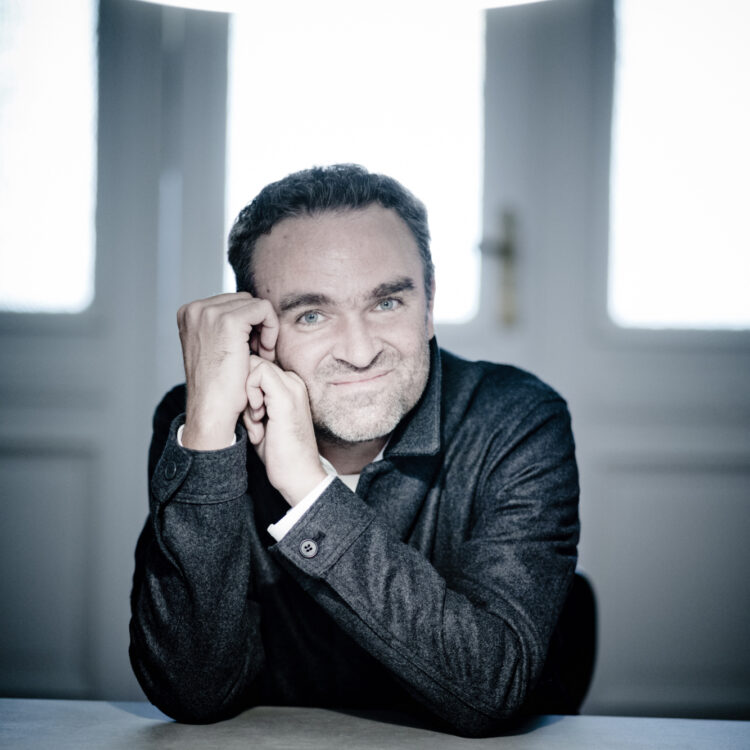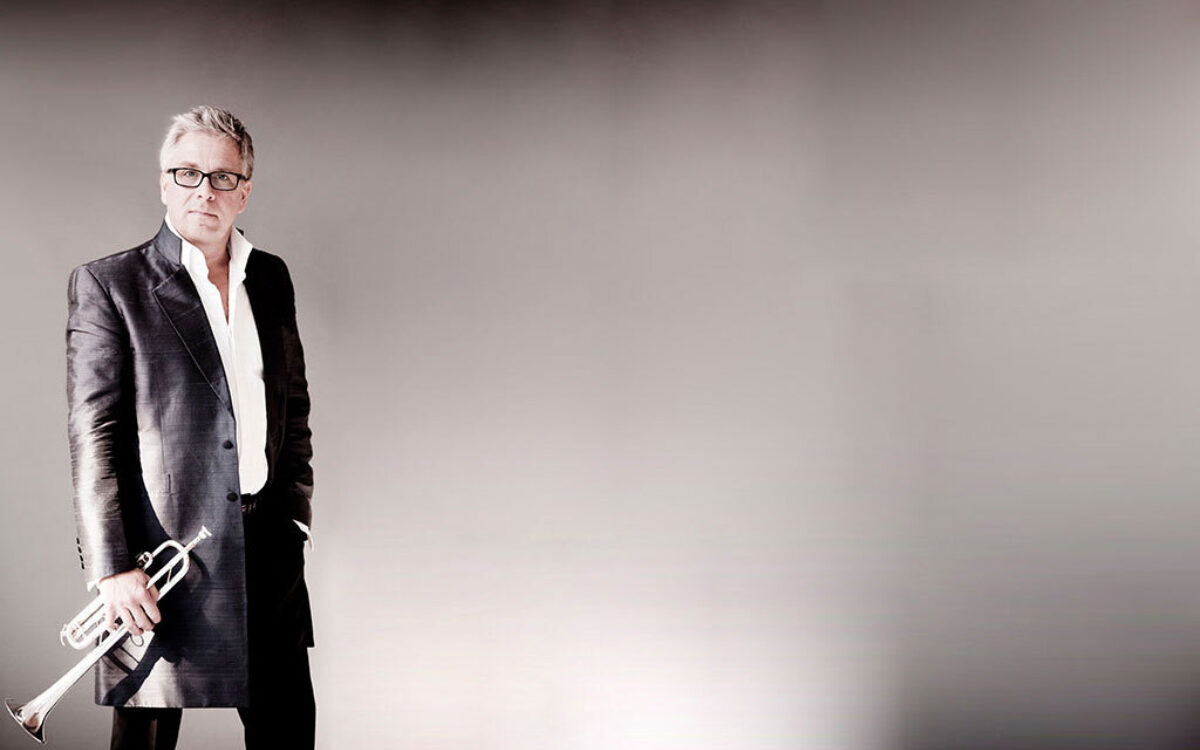Towards Paradise (Labyrinth VI), for trumpet and orchestra
Quick Facts
- Born: June 19, 1973, Munich, Germany
- Work completed: 2021
- First performance: September 23, 2021, Gewandhausorchester Leipzig, Andris Nelsons conducting, with soloist Håkan Hardenberger (world premiere)
- First BSO performance: November 18, 2021, Andris Nelsons conducting, with soloist Håkan Hardenberger (U.S. premiere)
- Approximate duration: 37 minutes
Jörg Widmann was born in Munich, Germany, on June 19, 1973, and lives in Munich and Berlin. He composed his trumpet concerto Towards Paradise (Labyrinth VI) for soloist Håkan Hardenberger on a joint commission from the Gewandhausorchester Leipzig and from the Boston Symphony Orchestra, Andris Nelsons, Music Director, through the generous support of the New Works Fund established by the Massachusetts Cultural Council, a state agency. He completed the score in 2021. Hardenberger was soloist in both the world and the American premieres, with Andris Nelsons leading the Gewandhausorchester Leipzig on September 23, 2021 and the Boston Symphony Orchestra on November 18, 2021.
In addition to the solo trumpet, the score of Towards Paradise (Labyrinth VI) calls for 3 flutes (2nd and 3rd doubling piccolo), 3 oboes (2nd doubling English horn), 3 clarinets (2nd doubling bass clarinet, 3rd doubling contrabass clarinet), 3 bassoons (3rd doubling contrabassoon), 4 horns, 3 trumpets, 3 trombones (3rd doubling bass trombone), tuba, timpani, percussion (5 players recommended: I. glockenspiel, crotales, xylophone, 2 plate bells, triangle, 3 cymbals, sizzle cymbal, snare drum, 3 tom-toms, bass drum, metal chimes, ratchet, wood block, waterphone; II. glockenspiel, xylophone, vibraphone, tubular bells, 3 cymbals, Chinese cymbal, Thai gongs, 3 tam-tams, water tam-tam, 2 high Brazilian tambourines, 2 bongos, snare drum, 3 tom-toms, bass drum, flexatone, guiro; III. tubular bells, 3 plate bells, triangle, 3 cymbals, Chinese cymbal, sizzle cymbal, crash cymbals, Thai gongs, tam-tam, 2 Brazilian tambourines, 2 bongos, snare drum, 3 tom-toms, bass drum, rain stick; IV. 3 plate bells, triangle, 3 cymbals, Chinese cymbal, sizzle cymbal, Thai gongs, water gong, 3 tam-tams, tambourine, bass drum, metal chimes, ratchet, mounted castanets, 3 temple blocks, metal block (with 2 hammers), rain stick, whip, flexatone; V. 3 tam-tams, ratchet), 2 harps, accordion, celesta, and strings (12 first violins, 10 second violins, 8 violas, 6 cellos, 4 double basses). Duration is about 37 minutes.
Towards Paradise (Labyrinth VI) is the second Jörg Widmann piece co-commissioned by the Boston Symphony Orchestra and the Gewandhausorchester Leipzig; the first was his big orchestra work Partita, which Andris Nelsons led in its world premiere in Leipzig in March 2018 and its American premiere later that month. The BSO first performed Widmann’s music in October 2016, when Nelsons led the composer’s Trauermarsch (“Funeral March”) for piano and orchestra, featuring soloist Yefim Bronfman. In 2017 Widmann became the first-ever Gewandhauskomponist (“Gewandhaus-Composer”) in the Gewandhausorchester’s long and storied history; the appointment entails both orchestral and chamber-music performances of his own compositions as well as appearances as clarinet soloist in a wide range of repertoire.
Widmann’s music admits virtually any sonic possibility, from triads and traditional scales to unfamiliar sounds produced via extended techniques. As an outstanding professional clarinetist himself and, more recently, as a conductor, he is steeped in the past 250 years of European music history and has embraced its influence. He studied clarinet with Gerd Starke in Munich and with Charles Neidich at the Juilliard School and as a composer worked with such teachers as Hans Werner Henze, Heiner Goebbels, Wilfried Hiller, and Wolfgang Rihm, all notably eclectic artists whose music employs diverse styles and techniques toward dramatic ends.
Widmann’s stature as a world-class clarinetist working with equally high-level performers throughout Europe doubtless played a role in solidifying his reputation as a composer. By his mid-twenties his music had been championed by such musicians as violinist and conductor Christoph Poppen, violinist Isabelle Faust, cellist Jan Vogler, and many others. In the U.S., he and his music were a focus of Carnegie Hall’s “Making Music” series during the 2011-12 season, and he has held summer residencies at the Marlboro and Yellow Barn festivals, both in Vermont, where he finds the environment particularly conducive to composing.
Working in virtually all genres from experimental miniatures to full-scale operas, Widmann has written a number of works for orchestra with a solo role. In addition to Trauermarsch, these include substantial works for voice, clarinet, flute, and viola, along with several very large-scale concertos that Widmann refers to as “epic”—the two violin concertos, the cello-and-orchestra work Dunkle Saiten (“Dark Strings”), and the Oboe Concerto. At 37 minutes, Towards Paradise is on this same epic scale, but though the composer is circumspect about calling the piece a “concerto,” neither does he deny its place in that tradition. He had already sidestepped the concerto designation in his previous piece for trumpet and orchestra, the unremittingly fast and intense ad absurdum (2002). Here, likewise, the evocative, multi-layered title keeps the concerto concept—soloist in conflict or cooperation with the orchestra—at bay, suggesting a more general narrative. “Towards Paradise” evokes the journey; its pairing with “Labyrinth” tells us that the journey isn’t a straightforward one. The Roman numeral “VI” places the new piece in the context of Widmann’s five previous Labyrinth pieces, covering some sixteen years and ranging in scope from solo soprano (V) to large string orchestra (I). That first Labyrinth was itself the third in a trilogy of works inspired by Greek myth.
It was while writing the first Labyrinth in 2005 that Widmann became preoccupied with the labyrinth as a metaphor for the artistic process. Through these works, he has questioned the accepted practices of the symphony orchestra and its repertoire, including the standards of orchestration, the relationship between soloist and orchestra, and even the use of the stage and auditorium for a concert work. In a live performance of Towards Paradise, it’s this last aspect of that stands out, but the theatrical dimension of the piece is inextricable from the drama of the music. Although the character of that drama is wide-ranging, it was the composer’s intention to write a concerto that mostly eschewed fire and flash in favor of lyricism, much like, say, Beethoven’s Violin Concerto. The composer writes,
After my hypertrophic virtuoso concert piece ad absurdum 20 years ago, I now felt the urge to compose a large-scale, angelic lyrical trumpet concerto: Towards Paradise. The trumpet soloist sets off on a labyrinthine journey through a wide spectrum of psychological and tonal zones, also featuring wild and craggy orchestral abysses leading into the open—towards a utopian state of suspension.
The lyrical nature of the trumpet’s role is established through an extended introductory solo that begins in the lowest range of the instrument. The sweetly melancholy melody is enhanced by the visual: we don’t, at first, know where the sound might be coming from. The ambiguity is enhanced when an orchestral trumpet joins in. Only gradually does the soloist assume the traditional solo location, but the precedent of movement has been set for the soloist seeking a way physically through the orchestral labyrinth.
The added physical dimension of motion across the stage and through the maze of the orchestra required careful consideration by the Symphony Hall stage crew, accustomed as they are to standard orchestral setups, in spite of a radical expansion of the ensemble from Wolfgang Mozart’s symphonies to Igor Stravinsky’s Rite of Spring. For Towards Paradise there are seven different stations for the trumpet; this number may be adjusted from one venue to another, depending on the size of the stage. The journey is not simply theatrical but has clear sonic implications. When the player’s back is to the audience, or playing with the bell toward the stage, or pointed outward toward the listener, the sound quality of the instrument changes, an effect that Widmann is careful to exploit throughout the piece.
The composer hit upon this idea while working in the studio with Hardenberger, who illustrated the clear changes in timbre that could be achieved through relatively simple movements. In this he demonstrated the playing styles of Miles Davis, one of Widmann’s musical heroes, who famously performed with his back to the audience, with the trumpet’s bell pointing to the floor, or with mutes, creating a wide array of soloistic colors as well as a unique psychological interplay with the audience. (In an interview, Widmann mentions seeing Miles Davis three times in concert.) The melodic mood that opens the piece shows Davis’s musical influence. With Davis in the background, Widmann also thought a lot about the Boston Symphony Orchestra’s sound and the solid American tradition of orchestral brass while writing the concerto. Reveling in the chance to hear the piece introduced by two great orchestras on two continents, he came to think of the American premiere of Towards Paradise in Boston as a kind of homecoming for it.
The trumpet’s changes in timbre through movement are extended by the use of mutes and enhanced by its being paired with different instrumental groups around the stage, each of which has its own personality or culture. Different groups call for different musical responses: percussion might elicit a fragmented, pointillist texture; the horn choir a sustained line. The vast percussion array includes gongs whose strange harmonics lead the trumpet to bend and morph pitches and timbre. Almost infinite varieties of timbre and texture are available from the nuanced combinations of percussion with the standard orchestral instruments, plus such unusual ones as the accordion and the contrabass clarinet, used in the deepest, darkest moments of the piece. The soloist might also suggest the material to be explored, such as in the long introduction and in a playfully syncopated passage that dominates the middle of the piece, which eventually makes its way to most of the orchestra.
With a poignancy that matches the fundamental lyricism of the concerto’s protagonist, Widmann has compared these orchestral travels to the state of the world in the past couple of years—the complications of moving from one place to another during the pandemic, the tenuousness of re-establishing contact and starting new friendships. More positively, the piece also represents the curiosity of the traveler and the artist, who is impelled to take these risks and to discover a new and richer relationship to the world.
Robert Kirzinger
Composer and writer Robert Kirzinger is Director of Program Publications of the Boston Symphony Orchestra.


